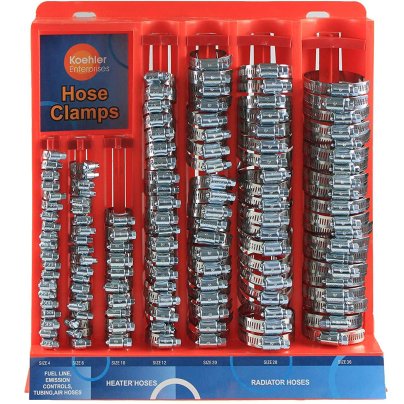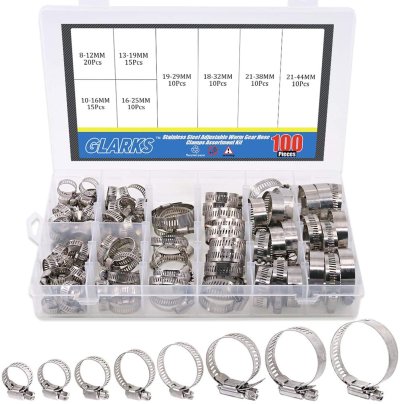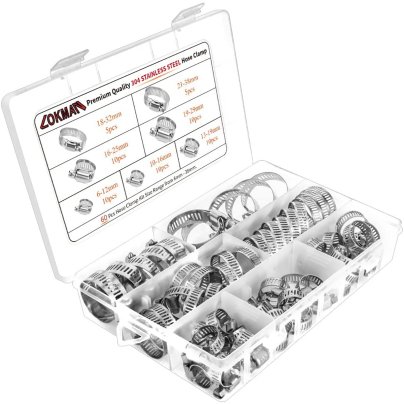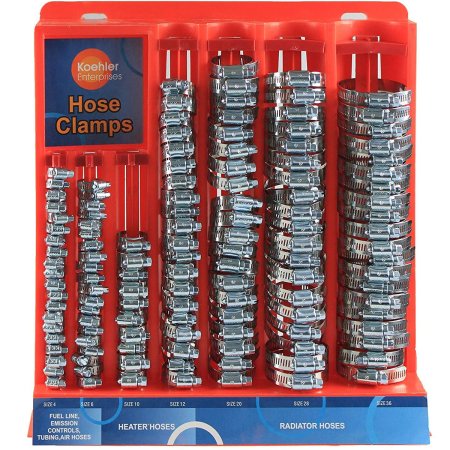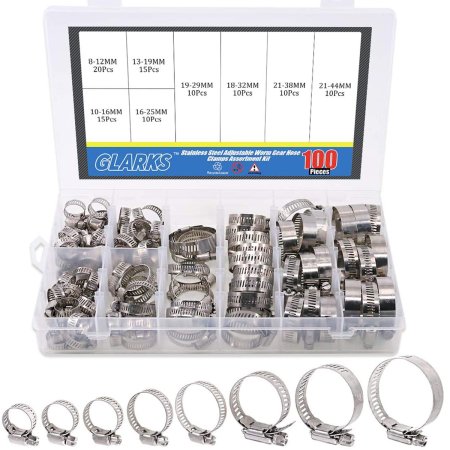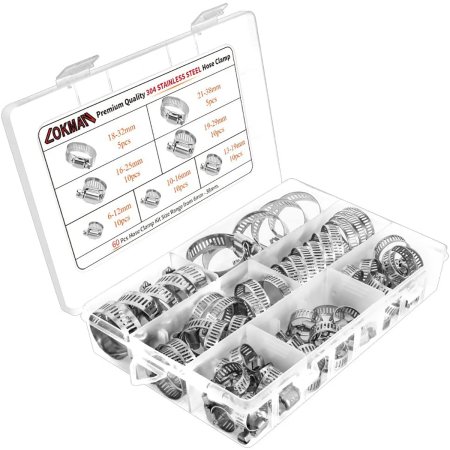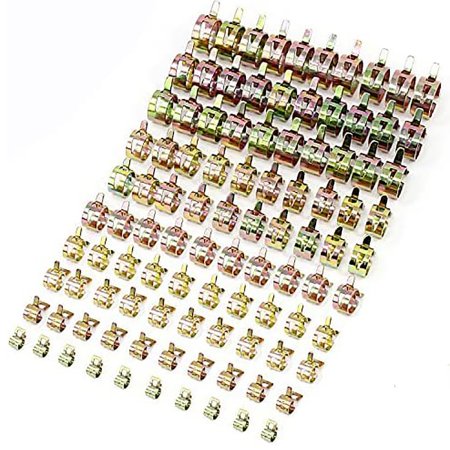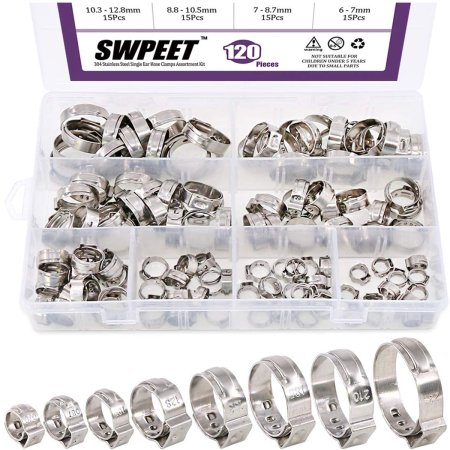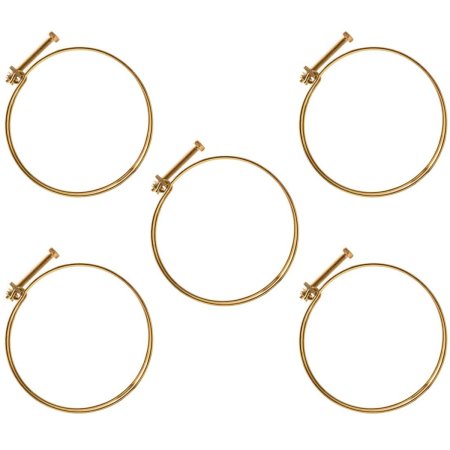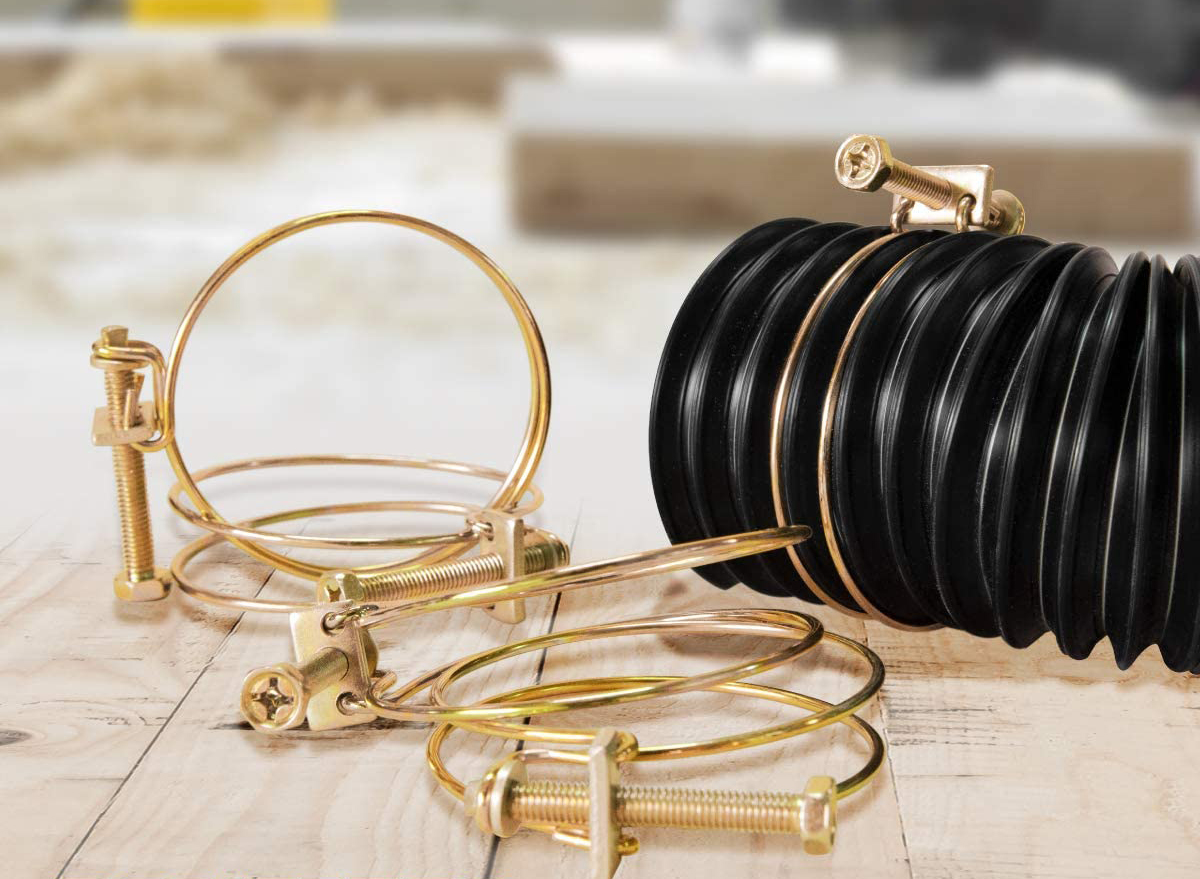
We may earn revenue from the products available on this page and participate in affiliate programs. Learn More ›
Whether working on a plumbing pipe fixture under a sink or performing automotive maintenance, connecting a hose to a fitting requires a bit of pressure to prevent leaks. That’s a job for a hose clamp.
When one thinks of clamps, what comes to mind is probably a two-handled tool that clamps down to hold material tightly in place, such as spring clamps, commonly used in woodworking. But hose clamps have a different function. These handy devices slide over the end of a hose and tighten down, applying even pressure over the circumference to cut off the flow and stop leaks. For those who haven’t used a hose clamp before, it might be challenging to choose the best hose clamps from the various products available on the market. This guide will help.
- BEST OVERALL: Koehler Enterprises KEDIS220 220 Piece Hose Clamp Set
- BEST BANG FOR THE BUCK: Glarks 100Pcs Adjustable 8-44mm Range 304 Stainless
- BEST SCREW CLAMPS: Hose Clamp, LOKMAN 60 Pieces Stainless Steel
- BEST SPRING CLAMPS: OCR 6-22mm 10Size Fuel line Spring Clamp
- BEST EAR CLAMPS: Swpeet 120Pcs 8 Sizes 304 Stainless Steel Single Ear
- BEST WIRE CLAMPS: POWERTEC 70101 4″ Double Wire Hose Clamp
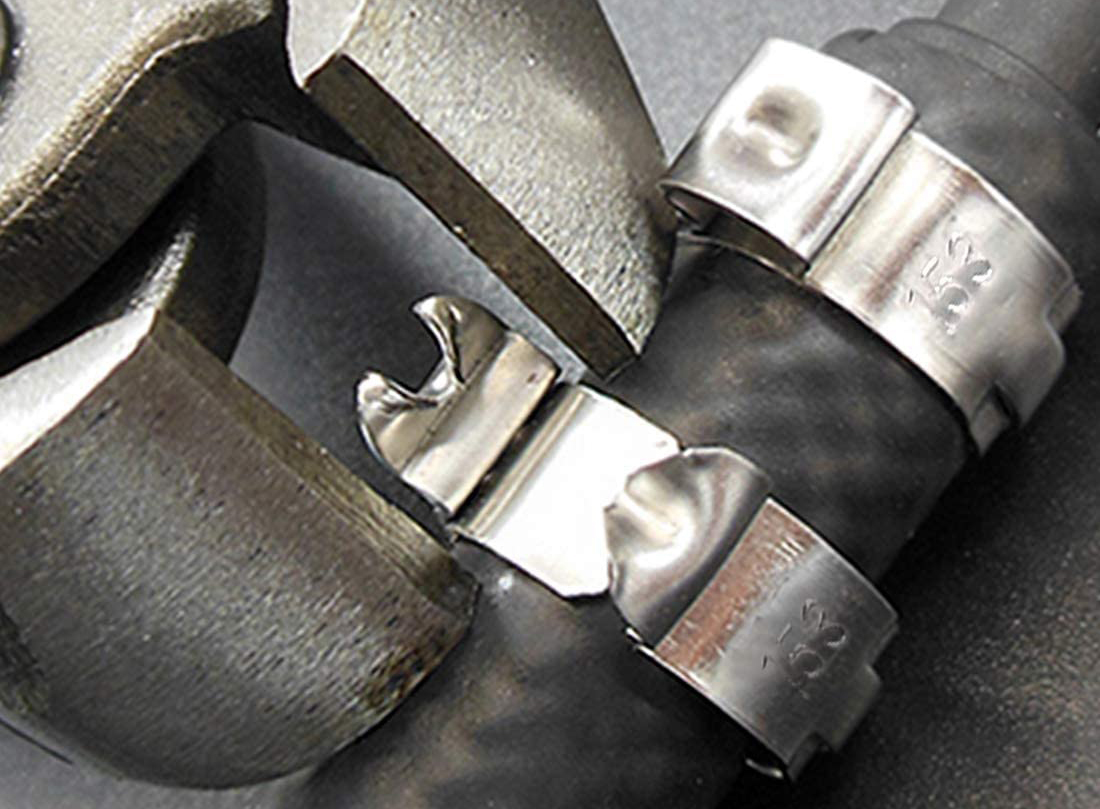
What to Consider When Choosing the Best Hose Clamps
Before shopping for the best hose clamps for your projects, there are a few important points to consider. This section will outline those factors, including adjustability, compatibility, and materials. Be sure to read this section carefully to understand all that goes into choosing the best hose clamps.
Type
There are a few different types of hose clamps, and they each have their strengths and functions.
- Screw clamps: Screw-style hose clamps feature a long stainless steel band that wraps around itself as well as a screw that the installer can use to tighten the band. As the installer tightens the screw, it pulls the two ends of the band in separate directions, applying a lot of pressure. Also, their design allows screw-type hose clamps to adjust for several sizes of hose.
- Spring clamps: Spring-style hose clamps are made from one piece of steel bent to a specific diameter. There are two tabs that the user can squeeze with a pair of pliers to open the clamp. Once released, the clamp springs shut, applying pressure to the hose. These clamps are fast to install, but they’re not adjustable. They can also be a bit finicky in tight spots.
- Ear clamps: Ear-style clamps are made from one band of metal that wraps around itself like a screw-type clamp but quite a bit thicker. These clamps have a metal tab that sticks up from the band and several corresponding holes for the tab to slip into. The installer uses a special pair of pliers to squeeze the ear (a collapsible section of the clamp), pulling the clamp shut and allowing the tab to drop into place.
- Wire clamps: Wire clamps are very similar to spring clamps, but instead of springing shut, their spring force resists closing. To shut a wire clamp, the user tightens a bolt and nut, pulling the wire clamp tight and applying even pressure. These can apply a lot of pressure over a relatively small surface area, creating very tight seals.
Material
Hose clamps are put in some difficult positions—quite literally. They’re often in damp environments or exposed to corrosive liquids. For that reason, it’s important to choose one made from the best material so the repair or installation will last and stay leak-free.
It’s almost a rule that the best hose clamps must be stainless steel in construction. Stainless steel is strong, durable, and resists corrosion. Heat-treated spring steel is also an option, though it’s not as corrosion resistant as stainless steel. Lesser materials will rust quickly, as condensation and chemicals will hasten the oxidation. Once a clamp becomes weak enough, it can separate under pressure.
Adjustability
Some clamps can work for several hose sizes, making them incredibly handy to keep on hand. While ear and wire clamps do offer some adjustability, the most adjustable are screw-type clamps.
In general, hose clamps can offer between ¼ to ½ inch of adjustability, though some might provide more. In many cases, tightening beyond that range will misshape the clamp, causing uneven pressure that could buckle the end of the hose.
Also, taking a hose clamp past its usable range will affect whether you can reuse it after servicing the hose down the road.
Compatibility
Using the right type of clamp for a particular job is important. For example, tightening a hose over a barbed fitting with several ribs is not a job for a thinner clamp; if the clamp isn’t on perfectly straight, it won’t apply even pressure across a set of ribs—that’s a recipe for a leak.
For barbed fittings, using a clamp with a flat band like a screw-type or ear clamp is best. Spring-style clamps are excellent for clamping a hose over a grooved fitting, such as a radiator fitting in a vehicle.
The hose’s material doesn’t matter as much as sizing the clamp properly. Forcing a clamp that’s too small will cause the hose to buckle, if it even works at all. Using a clamp that’s too large simply won’t apply enough pressure.
Safety
There are a few points to consider when it comes to using hose clamps safely.
- Manufacturers stamp band-style clamps from long sheets of stainless steel. The stamping process can leave a razor-sharp edge on the end of the band. Be careful when handling them.
- Spring clamps can be a bit unstable when pinched in the jaws of a pair of pliers. It’s best to wear eye protection to avoid accidentally taking a rogue hose clamp to the eye.
- While a hose clamp is a simple design, they do apply pressure very quickly. If you’re holding the clamp in place while tightening, be sure to hold the outside of the clamp. Any skin caught between the clamp and the hose is susceptible to a nasty little injury.
Our Top Picks
With that primer on the best hose clamps, choosing the best type for a project won’t be quite as challenging. The following list of some of the best hose clamps will make it even easier. Be sure to compare each type to choose the right one for the project, and be sure to keep the top considerations in mind.
Best Overall
Koehler Enterprises KEDIS220 220 Piece Hose Clamp Set
When it comes to choosing the right hose clamp for the job, Koehler’s KEDIS220 Clamp Set can get the job done. This 220-piece set of screw-type hose clamps has all the common sizes for projects like fuel lines, emissions, heater hoses, and radiator hoses, helping make home repair shops a bit more well rounded.
This kit comes with a mountable rack, providing a handy way to store these stainless steel hose clamps. The set comes with clamps for hoses from ¼ inch to 2 ¾ inches in diameter. The rack comes with 130 clamps preloaded, with an additional 90 pieces in a box for reloading.
Best Bang For the Buck
Glarks 100Pcs Adjustable 8-44mm Range 304 Stainless
Finding a full complement of hose clamps doesn’t always mean blowing your budget. Glark’s 100-piece set of screw-type hose clamps proves it. This kit comes in a clear plastic case full of adjustable clamps made from 304 stainless steel, making them strong, durable, and corrosion-resistant.
This kit comes with several clamps in different sizes, including 8 to 12 millimeters, 10 to 16 millimeters, 13 to 19 millimeters, 16 to 25 millimeters, 19 to 29 millimeters, 18 to 32 millimeters, 21 to 38 millimeters, and 21 to 44 millimeters. In SAE, this set covers hoses between 5/16 inches and 1 23/32 inches. Glark’s does offer other kits as well, including sets for larger hoses.
Best Screw Clamps
Hose Clamp, LOKMAN 60 Pieces Stainless Steel
Anyone searching for a set of high-quality screw-type hose clamps should check out this set of stainless steel clamps from Lokman. This kit comes with a clear plastic case filled with screw-type hose clamps, offering an assortment of corrosion-resistant clamps for a variety of projects. These clamps are suitable for plumbing, automotive, and mechanical applications.
This kit comes with hose clamps in seven different sizes, including 6 to 12 millimeters, 10 to 16 millimeters, 13 to 19 millimeters, 16 to 25 millimeters, 19 to 29 millimeters, 22 to 32 millimeters, and 25 to 38 millimeters. Should the project require larger clamps, Lokman sells several other sizes, including 33 to 57 millimeters and 46 to 70 millimeters.
Best Spring Clamps
OCR 6-22mm 10Size Fuel line Spring Clamp
Whether it’s repairing vacuum hoses and fuel lines under the hood of a vehicle or clamping a small-diameter water line to an icemaker or refrigerator, this kit of spring clamps from OCR has a clamp for virtually any small project. These clamps are made from strong spring steel, meaning they’ll be long lasting and reusable over and over again.
This kit includes 10 pieces of 10 different sizes, including 6, 8, 10, 12, 14, 15, 16, 18, 20, and 22 millimeters, covering the gamut of small hoses. Keep in mind that these small clamps can be difficult to hang on to while installing, so a tool like a set of flexible hose clamp pliers can help.
Best Ear Clamps
Swpeet 120Pcs 8 Sizes 304 Stainless Steel Single Ear
When an ear-style hose clamp is the clamp for the job, Swpeet’s set of stainless steel ear clamps is worth a look. This set of 120 pieces comes in a clear plastic kit, with eight different sizes of adjustable clamps. The sizes include 6 to 7 millimeters, 7 to 8.7 millimeters, 8.8 to 10.5 millimeters, 10.3 to 12.8 millimeters, 12.8 to 15.3 millimeters, 15.3 to 18.5 millimeters, 17.8 to 21 millimeters, and 20.3 to 23.5 millimeters.
Each of these clamps features 304 stainless steel construction, making them very strong and corrosion-resistant, so they’re suitable for applications in damp areas. The single-ear design makes them easy to install, especially when using a set of ear clamp pliers.
Best Wire Clamps
POWERTEC 70101 4" Double Wire Hose Clamp
Larger-diameter hoses often require a bit more bite from a hose clamp, and Powertec’s 4-inch Double Wire Hose Clamp provides it. This five-pack of hose clamps features an adjustable range between 3 11/16 and 4 3/8 inches, offering a bit of flexibility in application.
These wire hose clamps feature a bolt with a Phillips and hex-head combination, giving users two ways to clamp down on hoses in awkward positions. These clamps are carbon steel for durability and strength, and they’re also coated with zinc to improve their corrosion resistance. Powertec also offers these clamps in other sizes, including 2 1/2 inches and 5 inches.
FAQs About Hose Clamps
Now that you know a little more about the best hose clamps, you might have some questions about how they work or when to use them. The following is a collection of some of the most frequently asked questions about hose clamps, so be sure to check for an answer to your question below.
Q. How tight should I tighten my hose clamps?
Hose clamps are relatively thin, so they apply a lot of pressure. They don’t need to be extremely tight to make a seal. Simply tighten the clamp until it compresses the hose, there are no leaks, and you can’t pull the hose off of the fitting.
Q. How do I know what size hose clamp I need?
The easiest way to determine which size hose clamp you need is to measure the outside diameter of the hose. Once you have a rough idea of the hose size, matching the clamp won’t be an issue.
Q. Do hose clamps go bad?
Hose clamps can corrode and weaken over time. If you notice rust or corrosion on a clamp, you should replace it before it fails.
